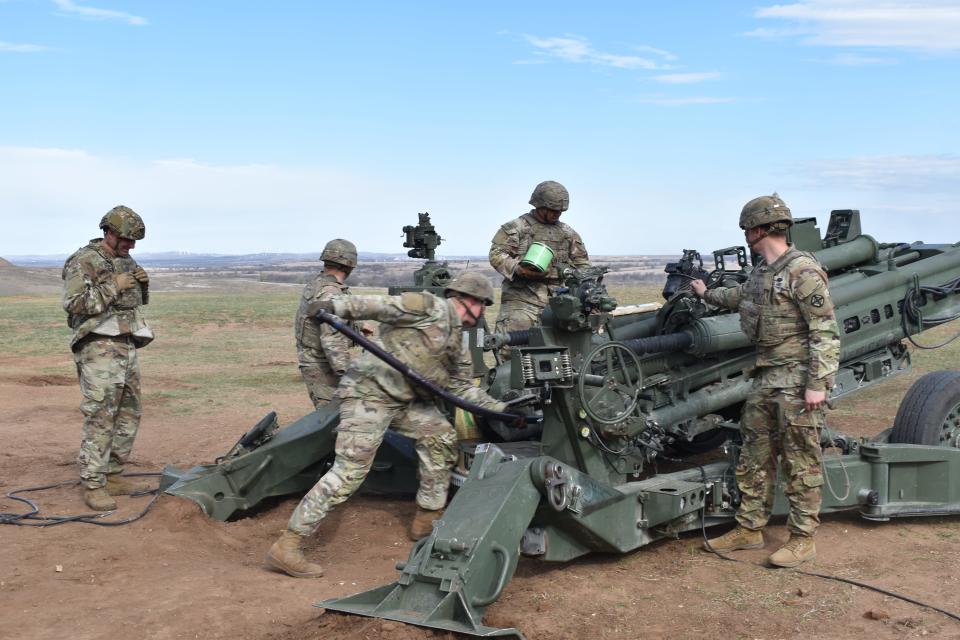I witnessed the full power of an M777 howitzer, and the piercing 'boom' of the artillery cannon shook me to my core
Business Insider recently traveled to Fort Sill, Oklahoma and saw US Army soldiers training on artillery.
Our reporter witnessed soldiers firing the M777, a powerful howitzer that's been used in Ukraine, among other wars.
The artillery piece made a very loud 'boom' when it fired, shaking the ground around it.
A 155mm shell is loaded into the massive, almost 10,000-pound gun. A few seconds later, a US Army soldier yells out. "Fire!"
At the tug of a thin rope, the deadly projectile is launched from the artillery cannon. Soaring into the sky, clearing hundreds of meters per second, it disappears from sight within moments. It is a bit like watching a golfer tee off with the largest golf ball you've ever seen, if the ball exploded violently on impact. In the distance, a plume of smoke emerges, followed by the thunderous sound of an explosion.
I recently traveled to Fort Sill, Oklahoma where I watched American soldiers conduct live-fire training on the M777 howitzer, a towed artillery piece that has emerged as one of Ukraine's more vital weapons in the fight against Russia.
Donning a protective flak vest and a helmet, the first thing I saw upon arrival at the firing range on that windy Thursday morning was soldiers operating an M119, a lightweight howitzer that fires 105mm rounds and looks like a weapon you might find on a battlefield in the first half of the 20th century.

It's a smaller system with a shorter range than the M777. But as I stepped out of the car and fumbled to put in my earplugs, I was still startled by the loud sound — sort of like a "bang" — that it made when fired. After training on the M119 for a few minutes, the artillerymen pivoted over to the M777, which was sitting nearby.
The M777 is a British-made weapon. It entered service in 2005 and first saw combat in the Middle East, specifically in Afghanistan. It is used by the ground forces of more than half a dozen countries, including the US and Ukraine.
The shell that the M777 fires, the 155mm projectile, has been a key munition for Ukrainian soldiers and is often at the center of the constant conversations about dwindling artillery ammunition — something that is currently proving to be major dilemma for Kyiv's forces as Russia presses forward on offense.
The US has sent Ukraine over 2 million 155mm rounds, according to Pentagon data from this month. But more are needed as the country fires a couple thousand of these shells a day, a fraction of what the Russians can unleash.

Firing the M777 is the definition of a team effort and, from an outside perspective, it's hectic to watch. Soldiers are performing various tasks and shouting different directions at one another. But obviously, it works when all these moving parts are combined.
With a heavy, 100-pound 155mm round loaded into the cannon, one soldier screamed "Fire!" while another pulled the thin rope that's connected to the system, effectively firing the system.
The projectile shot out from the M777's long barrel, which expelled a puff of gray smoke, and made a piercing "BOOM" that permeated through my entire body, shaking me to my core. I saw the impact of the shell hitting the ground a few miles away before I heard the blast.
Meanwhile, the soldiers were already onto their next shell, firing them off in rapid succession over the course of a few minutes. When it was over, there was a peaceful quiet that washed over the group. But it didn't last long, because it was soon time to pivot right back to the M119.

Sgt. Troy Mack, an artillery instructor at Fort Sill, said it's a "fun and exhilarating experience" to be able to shoot live rounds on the range. He said people may not realize how physically strenuous it is to operate these powerful systems, having to run around and work with lots of heavy items like 155mm and 105mm shells.
Staff Sgt. Steven Downey, another instructor at the facility, said it takes a lot of communication to work the M777, but he likes this howitzer so much because of the trust and cohesion that soldiers learn to develop over time.
"It builds the most proficient field artillerymen and the closest-knit teams out of the other pieces that I have experienced," he said.
Read the original article on Business Insider


